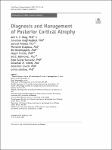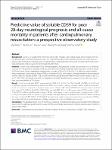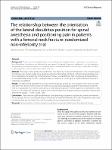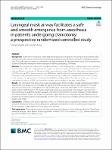Search
Author
- Daqing, Ma (3)
- Alexis, Ferré (2)
- Anna, Lybeck (2)
- Ashish K., Khanna (2)
- next >
Subject
- intensive care unit (8)
- acute respiratory dist... (5)
- chronic obstructive pu... (5)
- ICU (5)
- next >
Date issued
Has File(s)
Search Results
Various non-invasive monitoring techniques have been developed in recent years seeking to minimize the burden that repeated imaging and invasive procedures may inflict on the journey of patients with acute brain injuries (ABI). Furthermore, the combination of these methods may theoretically enhance their predictive value for functional outcomes, as well as the detection of alterations in intracranial compliance (ICC) and intracranial hypertension [1]. |
However, it should be noted that endobronchial biopsy (EBB), which is the biopsy method used in our study [2], is different from TBLB. TBLB is usually used to collect samples of peripheral lung lesions, diffuse lesions, or infiltrative lesions around the lung, meaning that the lesions commonly receive blood supply from both bronchial and pulmonary artery. In addition, TBLB is generally performed with or without X-ray guidance, and it is usually difficult to see the lesions under the direct view of the bronchoscope. Nevertheless, in our study, lung cancer samples were collected using EBB. On the one hand, the main blood supplies to lung cancer come from the bronchial arteries [3, 4], thus, the pulmonary artery pressure has anatomically little influence with EBB-induced bleeding. |
The study aims to provide a summary of recent developments for diagnosing and managing posterior cortical atrophy (PCA). We present current efforts to improve PCA characterisation and recommendations regarding use of clinical, neuropsychological and biomarker methods in PCA diagnosis and management and highlight current knowledge gaps. |
sCD59, as a soluble form of CD59, is observed in multiple types of body fluids and correlated with the cell damage after ischemia/reperfusion injury. This study aims to observe the dynamic changes of serum sCD59 in patients after restoration of spontaneous circulation (ROSC) and explore the association of serum sCD59 with neurological prognosis and all-cause mortality in patients after ROSC. |
Accurately evaluating the lymph node status preoperatively is critical in determining the appropriate treatment plan for non-small-cell lung cancer (NSCLC) patients. This study aimed to construct a novel nomogram to predict the probability of lymph node metastasis in clinical T1 stage patients based on non-invasive and easily accessible indicators. |
In Mycobacterium avium complex pulmonary disease (MAC-PD), diagnosis requires a positive culture from at least two separate expectorated sputum specimens. The optimal number of sputum examinations remains unclear. |
Perioperative hypotension increases postoperative complication rates and prolongs postoperative recovery time. Whether Passive Leg Raising test (PLR) and Subclavian Vein Diameter (DSCV) can effectively predict post-anesthesia hypotension remains to be tested. This study aimed to identify specific predictors of General Anesthesia (GA)induced hypotension by measuring DSCV in the supine versus PLR position. |
To date, no clinical studies have investigated the relationship between positioning pain and orientation of the lateral decubitus position for hip fracture surgery. The aim of the present study was to test the hypothesis that performing spinal anesthesia in the lateral decubitus position with the fracture side up or down does not affect positioning pain in patients with a femoral neck fracture. |
Endotracheal extubation under deep anesthesia (deep extubation) has been proved to present stable hemodynamics and steady intracranial pressure during emergence from anesthesia in patients undergoing craniotomy. This study aims to examine, in comparison with deep extubation, if a laryngeal mask airway (LMA) could provide a safer and smoother emergence from anesthesia in patients undergoing craniotomy. |
In orthopedic and trauma surgery, pulsatile lavage systems are used to clean soft tissue. This may be necessary in septic surgeries or in case of contaminated wounds after trauma. Positive features such as reduction of bacterial contamination and removal of foreign particles are counterbalanced by negative aspects such as bacterial seeding in deeper tissue layers, damage to various tissues and even cases of air embolism. |










